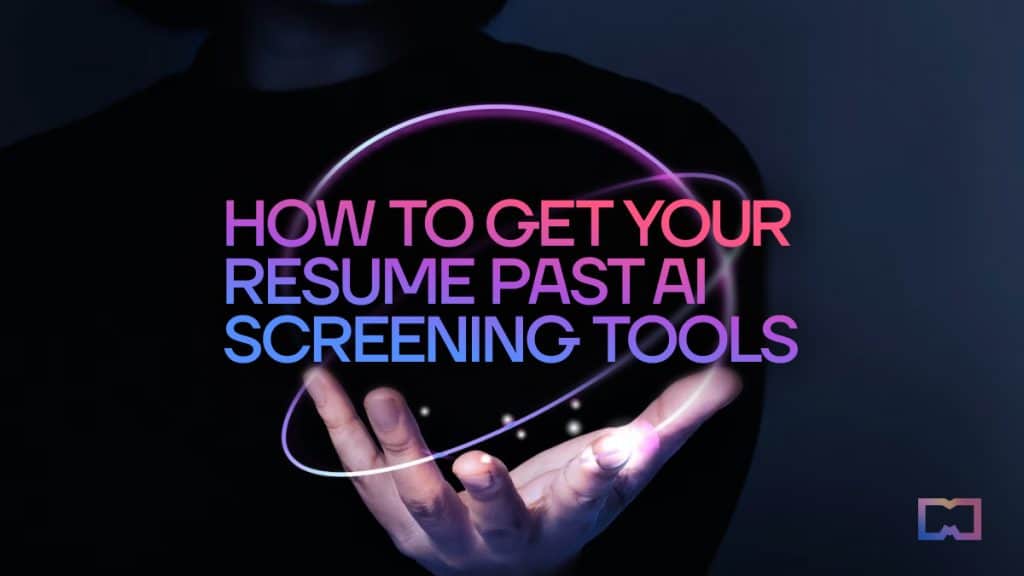5 Tips for Getting Your Resume Past AI Screening Tools


For each job posting, recruiters receive an avalanche of CVs as the labor market becomes more tech-driven and competitive. The sheer number of applications received can be too much for human recruiters to manually process.
To manage this influx efficiently and identify the most suitable candidates, many employers have turned to AI screening tools. These sophisticated algorithms streamline the hiring process by automating the initial stages of candidate selection. With artificial intelligence, recruiters can quickly sift through resumes, extract relevant information, and shortlist applicants based on predefined criteria.
Understanding the rationale behind the use of AI screening tools by recruiters can help job seekers appreciate the significance of customizing their resumes for the application process. AI screening tools find resumes that closely match the listed job requirements by utilizing natural language processing, machine learning, and pattern recognition. Human recruiters further evaluate the candidates who have been shortlisted by the AI screening tools, freeing them up to concentrate on determining which candidates are the most qualified for the position.
| Pro Tips |
|---|
| 1. Check out these top-rated AI resume builders and CV makers for 2023 that can help you create a professional and eye-catching resume effortlessly. |
| 2. Look into starting your own AI business or startup if you don’t want to work as an employee. |
| 3. Also, check out these ChatGPT plugins to improve productivity and streamline your workflow. |

The importance of optimizing your resume
For jobseekers, getting their resume past AI screening tools has become a tough challenge to overcome. These tools act as the initial gatekeepers in the hiring process, and if a resume fails to meet the specific criteria set by the algorithms, it may never reach the hands of human recruiters. Without a tailored approach, highly qualified candidates risk being overlooked by automated systems, hindering their chances of landing their dream job.
Knowing how to optimize a resume for AI screening tools is no longer a choice but a necessity for jobseekers to stay competitive in the job market. While AI screening tools offer undeniable benefits in terms of time and resource efficiency, jobseekers must adapt to this digital transformation and understand the strategies needed to get their resumes past these tools.
By adopting the right strategies, candidates can increase their chances of passing the AI screening stage and progressing to the next rounds of the selection process, where their unique skills, experiences, and qualifications can shine through. If you’re currently looking for a job, here are five tips you can follow to get your resume past AI screening tools.
1. Tailor Your Resume to the Job Description
To get your resume past AI screening tools, one of the most important steps is tailoring your resume to align with the specific job description. AI algorithms are programmed to seek out relevant keywords and phrases mentioned in the job posting. Analyze the job requirements carefully and integrate those keywords naturally into your resume, particularly in the skills, experience, and summary sections. However, it’s essential to avoid the temptation of excessive keyword stuffing, as this could lead to a negative impact during the human review process.
By customizing your resume for each application, you demonstrate your genuine interest in the position and show the AI screening tools that you possess the qualifications they are looking for. Moreover, crafting a tailored resume enables you to showcase your skills and accomplishments that directly align with the employer’s needs, increasing the likelihood of your resume making it past the initial AI screening stage.
2. Use Standard Resume Formats and Keywords
AI screening tools often struggle to read complex resume formats or uncommon fonts, leading to misinterpretations or overlooked information. To ensure that your resume is effortlessly parsed by AI algorithms, stick to standard formats like PDF or Microsoft Word and use common fonts like Arial or Times New Roman. This simple adjustment can significantly improve the chances of your resume being correctly interpreted by AI screening tools.
Additionally, incorporating industry-specific keywords and jargon is essential. These keywords are usually specific to the job and the field you are applying for and are often found in the job description. Integrating relevant keywords not only helps the AI algorithms recognize your qualifications quickly but also demonstrates your familiarity with the industry’s terminology. However, these keywords should exist naturally and contextually within your resume, as any forced or out-of-place usage might trigger a red flag for both AI screening tools and human recruiters. Strike a balance between optimization and authenticity to maximize your chances of getting past the AI screening process.
3. Highlight Accomplishments and Quantifiable Results
When crafting your resume to get past AI screening tools, focus on highlighting your accomplishments and providing quantifiable results from your previous roles. AI algorithms have become increasingly sophisticated in evaluating resumes based on measurable data. Instead of merely listing job responsibilities, delve deeper into your achievements and impact in each position. Use specific metrics, such as revenue growth, cost savings, or project success rates, to showcase your contributions to previous employers.
By providing concrete evidence of your achievements, you make it easier for AI screening tools to recognize your value and potential as a candidate. Resumes that present quantifiable results often rank higher in the AI system and attract the attention of human recruiters during subsequent stages of the hiring process. This approach not only improves your chances of getting past AI screening tools but also positions you as a strong candidate for the role.
| Related: 10 Best AI Tools for Twitter in 2023 |
4. Avoid Irrelevant Information and Unnecessary Graphics
AI screening tools are programmed to seek out relevant information that aligns with the job requirements. Therefore, you should remove any irrelevant details that might distract from your core qualifications. Avoid including personal interests or unrelated experiences that do not add value to your application. Focus on presenting information that directly showcases your skills, qualifications, and work experience, ensuring that your resume is laser-focused on the specific job you are applying for.
In addition to avoiding irrelevant information, steer clear of unnecessary graphics, images, or elaborate formatting in your resume. While visual elements might make your resume visually appealing, they can hinder AI algorithms from accurately parsing your content. Stick to a clean and professional layout that prioritizes text and keeps your resume easy for AI screening tools to analyze. A well-structured, text-based resume increases the likelihood of your qualifications shining through the AI screening process.
5. Optimize Your LinkedIn Profile
An optimized LinkedIn profile can significantly impact your job search success, particularly when dealing with AI screening tools. Many companies use AI to cross-reference the information provided in your resume with your LinkedIn profile. Ensure that both your resume and LinkedIn profile are consistent in terms of work history, skills, and qualifications. Any discrepancies between the two could raise red flags and negatively affect your application.
Moreover, leverage your LinkedIn profile to reinforce your qualifications. Use the summary section to provide additional context about your career journey, showcase accomplishments, and demonstrate your passion for the industry. Engage with relevant content and participate in professional discussions to establish a strong online presence. A well-curated LinkedIn profile, complementing your tailored resume, can leave a positive impression on both AI algorithms and human recruiters, increasing your chances of making it to the next stages of the hiring process.
FAQs
AI screening tools have become indispensable in the hiring process due to their ability to efficiently handle large volumes of resumes. In today’s competitive job market, employers often receive hundreds or even thousands of applications for a single position. Manually reviewing each resume is time-consuming and resource-intensive. AI screening tools utilize advanced algorithms to quickly parse through resumes, extract relevant information, and identify candidates who closely match the specified job requirements. By automating the initial screening process, recruiters can focus their time and effort on evaluating the most promising applicants, leading to a more streamlined and effective hiring process.
Tailoring your resume for AI screening tools while remaining authentic involves striking a careful balance between keyword optimization and genuine representation of your qualifications. Start by thoroughly analyzing the job description and incorporating relevant keywords and phrases that align with your skills and experiences. However, avoid keyword stuffing or including skills you don’t genuinely possess, as this can be detrimental during the human review process. Focus on presenting your accomplishments and quantifiable results in each role, as AI algorithms appreciate concrete data. By showcasing your genuine achievements and aligning them with the job requirements, you increase your chances of passing AI screening tools while remaining true to your professional identity.
Adhere to standard resume formats such as PDF or Microsoft Word. Avoid using complex layouts, unconventional fonts, or graphics, as AI algorithms may struggle to interpret these elements accurately. Stick to professional and easy-to-read fonts like Arial or Times New Roman. Utilize clear headings and bullet points to organize your resume logically. Additionally, include your contact information, skills, work experience, and education in separate sections, making it easier for AI screening tools to categorize and evaluate the content effectively.
To complement your resume and improve your chances of passing AI screening tools, optimize your LinkedIn profile to align with your job applications. Ensure that your work history, skills, and qualifications on LinkedIn mirror the information presented in your resume. Use the summary section to provide additional context about your career journey and highlight key accomplishments. Engage with relevant content and participate in professional discussions to establish a strong online presence. A well-optimized LinkedIn profile can reinforce the information in your resume and provide a holistic view of your qualifications, increasing your overall visibility and appeal to both AI screening tools and human recruiters.
Using industry-specific keywords effectively in your resume involves identifying the most relevant terms and incorporating them naturally into your content. Start by carefully studying the job description and noting down the keywords and phrases that stand out. These may include technical skills, certifications, software tools, or industry-specific terminology. When describing your experiences, achievements, and qualifications, integrate these keywords strategically throughout your resume. However, be mindful of context and avoid excessive repetition, as AI screening tools can recognize unnatural keyword stuffing. Aim for a seamless integration of keywords that adds value to your resume and clearly showcases your alignment with the desired job requirements.
Conclusion
Navigating the world of job searching might seem like a Herculean task, especially for inexperienced fresh grads, but armed with these five essential tips, jobseekers can confidently optimize their resumes for success. Tailoring your resume to the job description, using standard formats and industry-specific keywords, highlighting accomplishments with quantifiable results, avoiding irrelevant information and graphics, and optimizing your LinkedIn profile will increase your chances of getting past AI screening tools and landing on the shortlist of potential candidates.
Remember, AI screening is just the initial step in the hiring process. A well-crafted resume, combined with genuine passion, relevant qualifications, and strong communication skills, will ultimately help you stand out as the ideal candidate for the job.
Read more about AI:
Disclaimer
In line with the Trust Project guidelines, please note that the information provided on this page is not intended to be and should not be interpreted as legal, tax, investment, financial, or any other form of advice. It is important to only invest what you can afford to lose and to seek independent financial advice if you have any doubts. For further information, we suggest referring to the terms and conditions as well as the help and support pages provided by the issuer or advertiser. MetaversePost is committed to accurate, unbiased reporting, but market conditions are subject to change without notice.
About The Author
Cindy is a journalist at Metaverse Post, covering topics related to web3, NFT, metaverse and AI, with a focus on interviews with Web3 industry players. She has spoken to over 30 C-level execs and counting, bringing their valuable insights to readers. Originally from Singapore, Cindy is now based in Tbilisi, Georgia. She holds a Bachelor's degree in Communications & Media Studies from the University of South Australia and has a decade of experience in journalism and writing. Get in touch with her via [email protected] with press pitches, announcements and interview opportunities.
More articles

Cindy is a journalist at Metaverse Post, covering topics related to web3, NFT, metaverse and AI, with a focus on interviews with Web3 industry players. She has spoken to over 30 C-level execs and counting, bringing their valuable insights to readers. Originally from Singapore, Cindy is now based in Tbilisi, Georgia. She holds a Bachelor's degree in Communications & Media Studies from the University of South Australia and has a decade of experience in journalism and writing. Get in touch with her via [email protected] with press pitches, announcements and interview opportunities.

















































